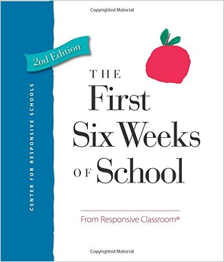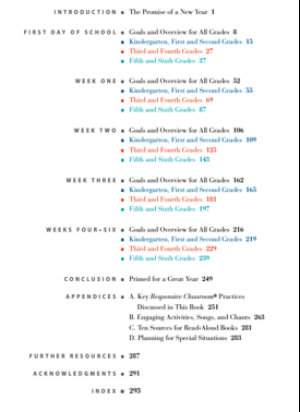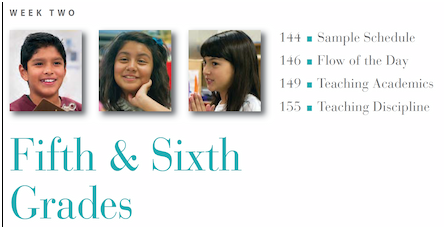Begin School Year with Responsive Classes
The First Six Weeks of School, 2nd Ed.
By Responsive Classroom
Special acknowledgement to Roxanne Kriete, Paula Denton and Mike Anderson
(Center for Responsive Schools, Inc., 2015 – Learn more)

Summer vacation is winding down and the school year is coming up quickly. It seems like summer goes by quite a bit faster than the other seasons.
If you’re anything like me, you’ve organized your professional books and mentor texts, had a brief chance to relax, reviewed your lessons from last year, and started to think about how to begin the new school year. Now is the time to really plan your instructional design.

As you begin to set up your classroom, you wonder where to start. All of the chart paper, neatly organized books, and empty desks are waiting for you to take charge. Floors are waxed and shined, desks are clean of any marks, windows are devoid of masking tape. Again, you wonder. What do I do first?
We know what the research says . . .
As educators, we know that research has proven you need to establish routines and set the classroom environment the first few weeks of school. But then reality rears its unkempt head. “I have to give pretests to determine what they remember from the summer… There is a first day of school assembly… What else can go wrong today?… Oops, I just got a new student who was not on my list. I have to hurry and make a desk plate for him… I need another copy of the welcome letter!”
Does it sound familiar? Years ago, I fell in love with the Responsive Classroom. When I first started using the Responsive Classroom philosophy in my classroom, I noticed a change in student behavior and motivation. My colleagues, wondering what I was doing right, approached me. Why did I come to school so excited every day? Why did it seem like my teaching was effortless? How exactly did I manage my classroom? Here’s the secret.
My companion over the years
My secret was I read The First Six Weeks of School, was inspired, and applied the book’s practices into my daily teaching repertoire. It was my “go to” book. The Northeast Foundation for Children has another secret that I want to shout to the world. The second edition is out! (Click image to read the table of contents.)
This amazing book walks you through the first six weeks of school beginning with the first day. It is divided into three color-coded levels (K-2), (3-4) and (5-6). Each section begins with the teaching goals and an overview of the key experiences that students should master during that time.
We all know the first few days are crucial to establish classroom management, routines, and expectations; to begin nurturing a sense of classroom ownership and set the tone by creating a climate of “warmth, inclusion, and safety” (p.3) .
I really enjoy the authors’ style of writing. Each section in the book is “to the point,” describing the scaffolding necessary to develop student independence. During the first two weeks of school, the students still rely on the teacher for support. With the gradual release of responsibility, students are enabled to do more on their own. For example, during the third week of school, students are encouraged to take risks such as volunteering to read the Morning Message.
What’s in the 2nd edition
Built on the same premise and format as the first edition, the new edition of The First Six Weeks of School includes a chapter on what to expect on the first day of school and continues through the first six weeks. Each week is organized into three parts: “Flow of the Day” (appropriately titled), “Teaching Academics,” and “Teaching Discipline.” If you use the detailed sample schedules for each grade level, your day will flow seamlessly.
Since I teach fourth grade, I essentially skimmed the other portions of the book and devoted my time to the section that addressed my students’ needs. What a treasure trove of ideas, schedules, charts, activities, resources. I couldn’t wait to dive into each page. Although it is jam-packed with ideas, the authors respect the individual teacher, encouraging them to adapt the ideas and samples to meet the needs of their students and the requirements of their district. I found the schedules the authors provided for the first six weeks easily adaptable to my classroom practice.
An essential for new readers, a refresher for returnees
The First Six Weeks of School is an important book for all teachers and administrators to have and use. Even if you have read the first book or feel that you have been teaching enough years to know how to begin the first few weeks, using this book as a refresher will benefit your students and YOU!
I am entering my 40th year of teaching and reading a book such as this reminds me of why I wanted to be a teacher and how crucial my role is. It reminds me that the classroom environment is not desks and chairs but how I establish my routines. “For routines to become routine, they need to be practiced correctly.” (p. 134)
Whether you are a Responsive Classroom veteran, never heard of it before, or you’ve decided to finally check it out, this book is an important resource to have. The second edition reflects current teaching practices and research of the best ways to structure your classroom from Day One.
The structure of the book gives simple “tips” on how to build a positive classroom community, how to engage and challenge students academically and make them want to come back the next day. By keeping this book handy and using it as a framework, you will find that discipline incidents will decrease, students motivation will increase (students will take ownership of their learning and challenge themselves), self-control and cooperation will be evident. I can’t wait for the first six weeks of school to begin!
Linda Biondi is a fourth grade teacher at Pond Road Middle School in Robbinsville, NJ, and a long-time Morning Meeting practitioner. She’s also the recipient of several educational grants, a Teacher Consultant with the National Writing Project and a participant on the NJ Department of Education Teacher Advisory Panel. Linda participates in ECET2 Celebrate Teaching which has posted an interview with her.





































